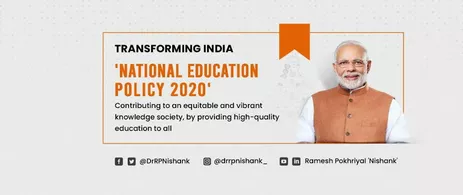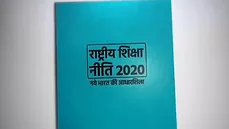
The new National Education Policy (NEP), endorsed in summer 2020, addresses the growing developmental imperatives of India. It recognizes that India is a global leader in information and communication tech and other cutting-edge domains, such as aerospace.
The NEP proposes revamping all aspects of the education structure, including its regulation and governance, to create a new system that is aligned with the goals of 21st century education. Moreover, the NEP intends to set up a Higher Education Commission of India as a single overarching umbrella body for the entire higher education, excluding medical and legal education.

Bundling of the different types of universities
Currently, India has eight types of universities, based on how they are funded, including whether they are state, centrally, or privately funded as well as 40,000 colleges without degree-awarding ability, and dependent on being affiliated with degree-awarding institutions. The policy aims to subsume the eight categories into three tier structures in higher education:
- Type 1: Research universities – They will aim to become world-class research universities and compete with global institutions.
- Type 2: Teaching universities – These universities will focus on high-quality teaching across disciplines and programs, including undergraduate, masters and doctoral, professional, vocational, certificate, and diploma programs, while also significantly contributing to cutting-edge research.
- Type 3: Colleges – These institutions will largely run undergraduate programs, will offer certificate, diploma, and degree courses in vocational education and in some fields of professional education.
As for PhDs, a requirement of either a master’s degree or a four-year bachelor’s degree with research will be needed. Hence, these three categories of degree-awarding institutions would result to greater institutional autonomy, a new National Research Foundation (NRF) and renewed commitment to allow foreign universities into India as part of an internationalization drive.

NRF – a promoter of a strong research culture
The NRF will be set up as a body for promoting and building a strong research culture and research capacity. It will also expand efforts in technology and play a key role in advancing core AI research, developing and deploying application-based research and advancing international efforts to address global challenges.
One of the NRF’s main objectives is to identify research-focused universities and help to develop their state-of-the-art research facilities to enable researchers to undertake innovative and pioneering research. The Ministry of Education proposes to set up an autonomous body, the National Educational Technology Forum (NETF), to provide a free platform for exchanging ideas about using technology to enhance learning, assessment, planning, and administration in both school and higher education.
To boost internationalization, institutions will have increased autonomy, thus changing the opportunities for partnerships and exchanges with foreign institutions. Educational institutions, such as the Indian Institutes of Technology (IIT) and Indian Institutes of Management (IIM) in India, will change from being single-discipline institutes to multidisciplinary.

IIT Kharagpur, IIT Delhi, and IIT Roorkee have started expanding to non-engineering disciplinaries. The new IITs will find it easier to align to the NEP 2020, considering their young faculty are more open to change. Interdisciplinarity, flexibility in credit requirements, lateral entry and exit, internationalization, and student focus are areas that are deeply engrained in the IITs. The NRF also aims to make apex educational institutes, such as IITs and IIMs, a part of the online education system.
New opportunities for international universities in India
For setting up foreign universities in India, the first step would be to have twinning arrangements leading to joint degrees between India and the respective international universities. Moreover, a bill will have to be amended in line with the NEP. Hence, foreign partnerships would continue the way they were, except there will be reduced regulatory hurdles. Thereby, the autonomy of an institution would mean that they would have increased exchange-making capacity, i.e. for student or faculty. As per the NEP, selected universities, for example, those from among the top 100 universities in the world will be facilitated to operate in India. These universities will be given dispensations regarding regulatory, governance, and content norms on par with other autonomous institutions of India.

Also under the NEP, there will be no rigid separations between arts and sciences, between curricular and extra-curricular activities, between vocational and academic streams. Undergraduate degrees will either be three- or four-year duration with multiple exit options within this period.
The policy adds that credits acquired at foreign universities can be counted towards a degree within India and that student and research exchanges will also be facilitated between Indian and global institutions. While the education ministry is inviting international universities to come and set up campuses here, they are also encouraging leading Indian institutions to open campuses abroad.
Education in India is still a state subject and hence each state will have to approve the policy, which is a long process. Thus, the NEP 2020 will enable TUM to further deepen their partnerships with institutes in India and nurture their existing partners.
Sources:
- theprint.in/india/education/govt-initiates-plan-for-iits-and-other-top-indian-institutes-to-open-campuses-abroad/490932/
- www.universityworldnews.com/post.php
- www.educationtimes.com/article/newsroom/77278410/nep-2020-interdisciplinary-humanities-programs-at-iits-will-boost-holistic-education-says-iit-kharagpur-director.html
- www.forbesindia.com/article/real-issue/nep-2020-can-india-attract-foreign-universities/61629/1
- www.indiatoday.in/education-today/news/story/foreign-university-campuses-welcome-nep-2020-1706434-2020-07-31
- www.mhrd.gov.in/sites/upload_files/mhrd/files/NEP_Final_English_0.pdf
- www.indiatoday.in/education-today/news/story/foreign-university-campuses-welcome-nep-2020-1706434-2020-07-31
- www.deccanherald.com/supplements/dh-education/the-implications-of-nep-on-higher-education-872515.html
- timesofindia.indiatimes.com/blogs/toi-edit-page/how-tech-is-shaping-education-technology-can-offer-more-flexibility-and-learning-support-than-traditional-formats/
- bweducation.businessworld.in/article/NEP-2020-Impact-On-Higher-Education-/07-08-2020-305999/
- www.dnaindia.com/education/report-nep-2020-centre-aims-to-bring-iits-iims-under-online-learning-seeks-inputs-from-ugc-aicte-2837375
- www.moneycontrol.com/news/business/economy/on-course-to-nep-2020-implementation-iits-look-to-shed-engineering-school-tag-5800751.html
- timesofindia.indiatimes.com/home/education/news/phase-wise-implementation-of-nep-will-start-this-month-amit-khare/articleshow/77296401.cms
- www.financialexpress.com/education-2/iits-on-nep-2020-new-education-policy-will-help-make-india-a-knowledge-hub/2042877/